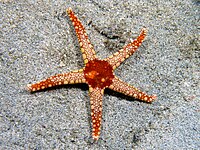
Reproduction in deep‐sea vent shrimps is influenced by diet, with rhythms apparently unlinked to surface production
Sign Up to like & getrecommendations! Published in 2022 at "Ecology and Evolution"
DOI: 10.1002/ece3.9076
Abstract: Abstract Variations in offspring production according to feeding strategies or food supply have been recognized in many animals from various ecosystems. Despite an unusual trophic structure based on non‐photosynthetic primary production, these relationships remain largely… read more here.
Keywords: production; surface production; reproduction; deep sea ... See more keywords

Adaptation and evolution of the sea anemone Alvinactis sp. to deep‐sea hydrothermal vents: A comparison using transcriptomes
Sign Up to like & getrecommendations! Published in 2022 at "Ecology and Evolution"
DOI: 10.1002/ece3.9309
Abstract: Abstract Sea anemones are diverse and ecologically successful members of Anthozoa. They are often found in intertidal and shallow waters, although a few of them inhabit harsher living conditions, such as deep‐sea hydrothermal vents. Here,… read more here.
Keywords: adaptation; deep sea; sea anemone; sea hydrothermal ... See more keywords

The global depth range of marine fishes and their genetic coverage for environmental DNA metabarcoding
Sign Up to like & getrecommendations! Published in 2023 at "Ecology and Evolution"
DOI: 10.1002/ece3.9672
Abstract: Abstract The bathymetric and geographical distribution of marine species represent a key information in biodiversity conservation. Yet, deep‐sea ecosystems are among the least explored on Earth and are increasingly impacted by human activities. Environmental DNA… read more here.
Keywords: deep sea; depth; coverage; genetic coverage ... See more keywords

Complex sublinear burrows in the deep sea may be constructed by amphipods
Sign Up to like & getrecommendations! Published in 2023 at "Ecology and Evolution"
DOI: 10.1002/ece3.9867
Abstract: Abstract Trails, burrows, and other “life traces” in sediment provide important evidence for understanding ecology—both of the maker and of other users—and behavioral information often lacking in inaccessible ecosystems, such as the deep sea or… read more here.
Keywords: ecology; deep sea; sublinear burrows; maker ... See more keywords

Functional traits provide new insight into recovery and succession at deep‐sea hydrothermal vents
Sign Up to like & getrecommendations! Published in 2021 at "Ecology"
DOI: 10.1002/ecy.3418
Abstract: Abstract Investigation of communities in extreme environments with unique conditions has the potential to broaden or challenge existing theory as to how biological communities assemble and change through succession. Deep‐sea hydrothermal vent ecosystems have strong,… read more here.
Keywords: succession; deep sea; sea hydrothermal; succession deep ... See more keywords

Short-term toxicity of 1-methylnaphthalene to Americamysis bahia and 5 deep-sea crustaceans.
Sign Up to like & getrecommendations! Published in 2017 at "Environmental toxicology and chemistry"
DOI: 10.1002/etc.3926
Abstract: There are few studies that have evaluated hydrocarbon toxicity to vertically migrating deep-sea micronekton. Crustaceans were collected alive using a 9-m2 Tucker trawl with a thermally insulated cod end and returned to the laboratory in… read more here.
Keywords: methylnaphthalene americamysis; deep sea; chemistry; toxicity ... See more keywords

Methane cold seeps as biological oases in the high‐Arctic deep sea
Sign Up to like & getrecommendations! Published in 2018 at "Limnology and Oceanography"
DOI: 10.1002/lno.10732
Abstract: Cold seeps can support unique faunal communities via chemosynthetic interactions fueled by seabed emissions of hydrocarbons. Additionally, cold seeps can enhance habitat complexity at the deep seafloor through the accretion of methane derived authigenic carbonates… read more here.
Keywords: deep sea; high arctic; methane; cold seeps ... See more keywords

Baseline soundscapes of deep‐sea habitats reveal heterogeneity among ecosystems and sensitivity to anthropogenic impacts
Sign Up to like & getrecommendations! Published in 2021 at "Limnology and Oceanography"
DOI: 10.1002/lno.11911
Abstract: Underwater soundscapes, though invisible, are crucial in shaping the biodiversity of marine ecosystems by acting as habitat‐specific settlement cues for larvae. The deep sea has received little attention in soundscape research, but it is being… read more here.
Keywords: sea; deep sea; soundscape; baseline soundscapes ... See more keywords

Benthic foraminifera in a deep-sea high-energy environment: the Moira Mounds (Porcupine Seabight, SW of Ireland)
Sign Up to like & getrecommendations! Published in 2018 at "Swiss Journal of Geosciences"
DOI: 10.1007/s00015-018-0317-4
Abstract: Cold-water coral ecosystems represent unique and exceptionally diverse environments in the deep-sea. They are well developed along the Irish margin, varying broadly in shape and size. The Moira Mounds, numerous small-sized mounds, are nestled in… read more here.
Keywords: foraminifera; deep sea; porcupine seabight; moira mounds ... See more keywords

Fictibacillus iocasae sp. nov., isolated from the deep-sea sediment in Pacmanus, Manus Basin
Sign Up to like & getrecommendations! Published in 2018 at "Archives of Microbiology"
DOI: 10.1007/s00203-018-1527-x
Abstract: A novel bacterium, designed strain S38T, was isolated from the deep-sea sediment of Pacmanus hydrothermal field in Manus Basin. The isolate was gram-positive, aerobic, motile, and was defined by endospore-forming rods. Strain S38T grew at… read more here.
Keywords: deep sea; sediment pacmanus; sea sediment; manus basin ... See more keywords

Trophic ecology of a deep-sea fish assemblage in the Northwest Atlantic
Sign Up to like & getrecommendations! Published in 2017 at "Marine Biology"
DOI: 10.1007/s00227-017-3236-4
Abstract: Understanding the trophic ecology of deep-sea communities provides valuable insight into deep-water ecosystem functioning, and can help inform fisheries management and conservation initiatives. However, few deep-sea food webs have been studied so far in the… read more here.
Keywords: deep sea; northwest atlantic; trophic ecology; ecology deep ... See more keywords